Australian Commercial Law: Analysis of Misrepresentation in Contracts
VerifiedAdded on 2021/06/17
|9
|2478
|79
Homework Assignment
AI Summary
This assignment solution addresses an Australian Commercial Law case concerning a contract dispute between Barry and Angelo, focusing on the concept of misrepresentation. The solution begins with an analysis of a hypothetical proposal by tribal elders, drawing parallels to Hart's theory of law, including rules of recognition, change, and adjudication. The core of the assignment then examines whether Barry has grounds to challenge the contract's validity based on Angelo's pre-contractual statements. It defines misrepresentation, distinguishes between pre-contractual statements and contract terms, and discusses the elements of actionable misrepresentation, including materiality and reliance, referencing relevant case law. Furthermore, the solution explores the remedies available to Barry, specifically rescission and damages, in the event of a breach of contract due to misrepresentation. The conclusion reinforces that Barry can challenge the contract's validity based on actionable misrepresentation and outlines the available legal remedies.
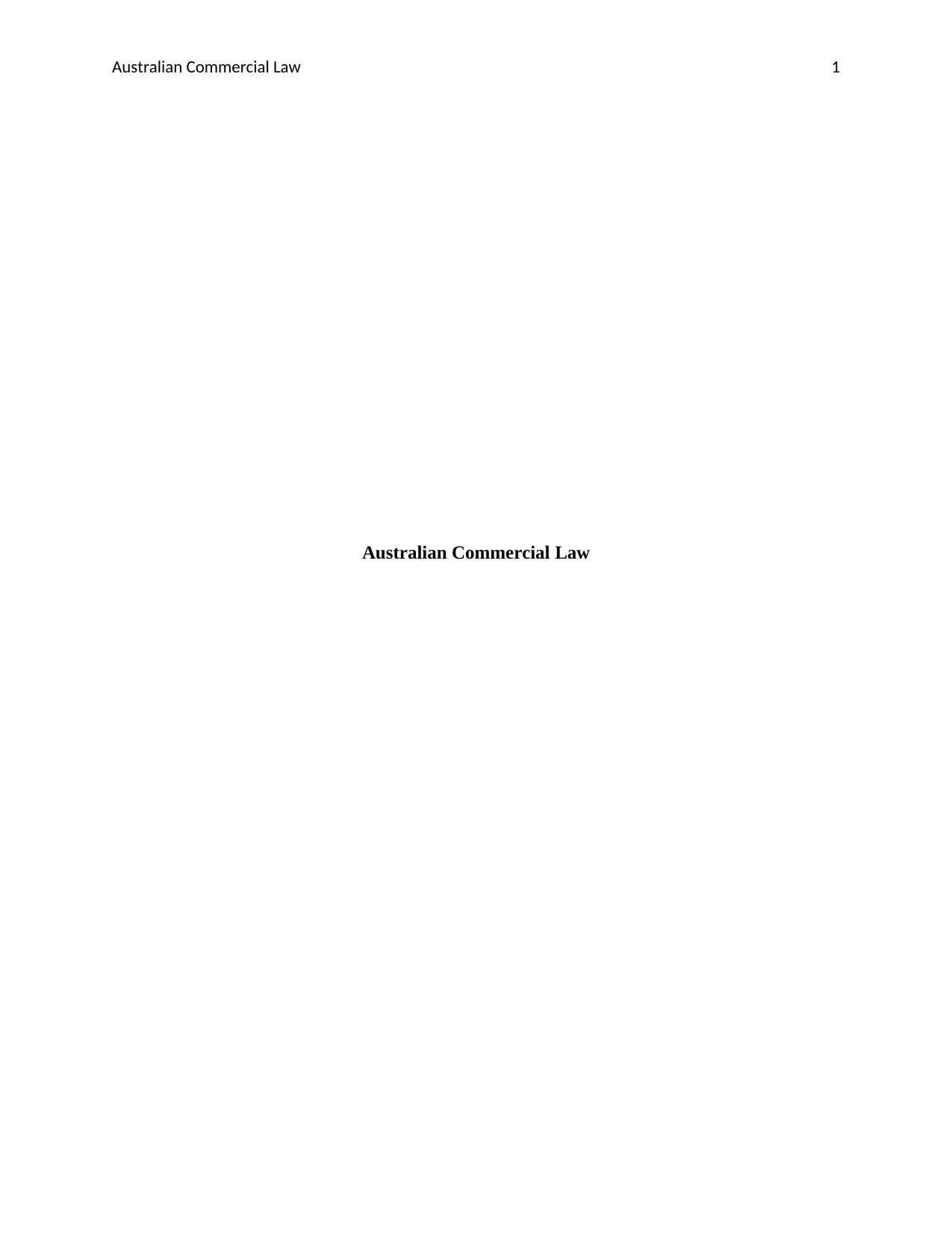
Australian Commercial Law 1
Australian Commercial Law
Australian Commercial Law
Paraphrase This Document
Need a fresh take? Get an instant paraphrase of this document with our AI Paraphraser
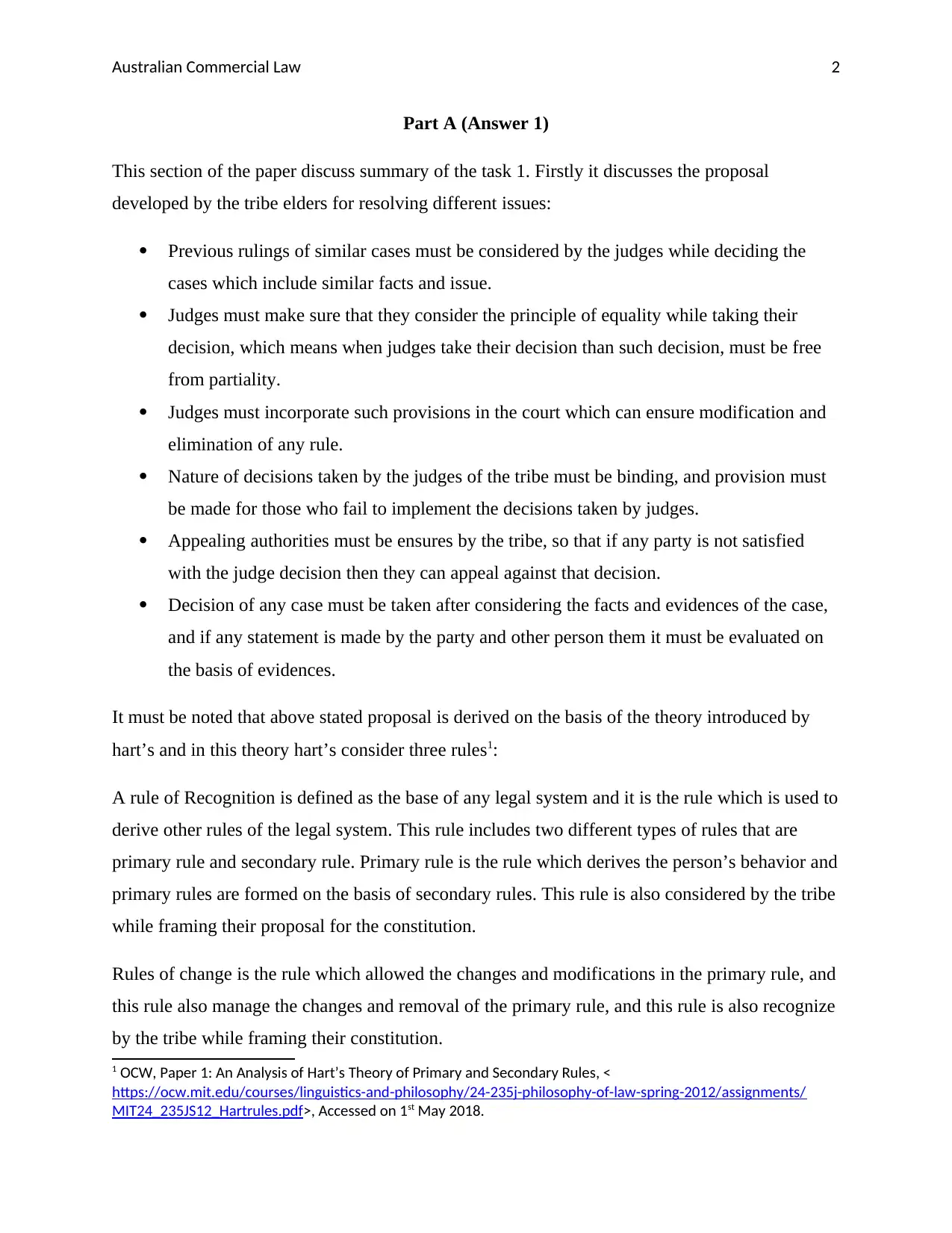
Australian Commercial Law 2
Part A (Answer 1)
This section of the paper discuss summary of the task 1. Firstly it discusses the proposal
developed by the tribe elders for resolving different issues:
Previous rulings of similar cases must be considered by the judges while deciding the
cases which include similar facts and issue.
Judges must make sure that they consider the principle of equality while taking their
decision, which means when judges take their decision than such decision, must be free
from partiality.
Judges must incorporate such provisions in the court which can ensure modification and
elimination of any rule.
Nature of decisions taken by the judges of the tribe must be binding, and provision must
be made for those who fail to implement the decisions taken by judges.
Appealing authorities must be ensures by the tribe, so that if any party is not satisfied
with the judge decision then they can appeal against that decision.
Decision of any case must be taken after considering the facts and evidences of the case,
and if any statement is made by the party and other person them it must be evaluated on
the basis of evidences.
It must be noted that above stated proposal is derived on the basis of the theory introduced by
hart’s and in this theory hart’s consider three rules1:
A rule of Recognition is defined as the base of any legal system and it is the rule which is used to
derive other rules of the legal system. This rule includes two different types of rules that are
primary rule and secondary rule. Primary rule is the rule which derives the person’s behavior and
primary rules are formed on the basis of secondary rules. This rule is also considered by the tribe
while framing their proposal for the constitution.
Rules of change is the rule which allowed the changes and modifications in the primary rule, and
this rule also manage the changes and removal of the primary rule, and this rule is also recognize
by the tribe while framing their constitution.
1 OCW, Paper 1: An Analysis of Hart’s Theory of Primary and Secondary Rules, <
https://ocw.mit.edu/courses/linguistics-and-philosophy/24-235j-philosophy-of-law-spring-2012/assignments/
MIT24_235JS12_Hartrules.pdf>, Accessed on 1st May 2018.
Part A (Answer 1)
This section of the paper discuss summary of the task 1. Firstly it discusses the proposal
developed by the tribe elders for resolving different issues:
Previous rulings of similar cases must be considered by the judges while deciding the
cases which include similar facts and issue.
Judges must make sure that they consider the principle of equality while taking their
decision, which means when judges take their decision than such decision, must be free
from partiality.
Judges must incorporate such provisions in the court which can ensure modification and
elimination of any rule.
Nature of decisions taken by the judges of the tribe must be binding, and provision must
be made for those who fail to implement the decisions taken by judges.
Appealing authorities must be ensures by the tribe, so that if any party is not satisfied
with the judge decision then they can appeal against that decision.
Decision of any case must be taken after considering the facts and evidences of the case,
and if any statement is made by the party and other person them it must be evaluated on
the basis of evidences.
It must be noted that above stated proposal is derived on the basis of the theory introduced by
hart’s and in this theory hart’s consider three rules1:
A rule of Recognition is defined as the base of any legal system and it is the rule which is used to
derive other rules of the legal system. This rule includes two different types of rules that are
primary rule and secondary rule. Primary rule is the rule which derives the person’s behavior and
primary rules are formed on the basis of secondary rules. This rule is also considered by the tribe
while framing their proposal for the constitution.
Rules of change is the rule which allowed the changes and modifications in the primary rule, and
this rule also manage the changes and removal of the primary rule, and this rule is also recognize
by the tribe while framing their constitution.
1 OCW, Paper 1: An Analysis of Hart’s Theory of Primary and Secondary Rules, <
https://ocw.mit.edu/courses/linguistics-and-philosophy/24-235j-philosophy-of-law-spring-2012/assignments/
MIT24_235JS12_Hartrules.pdf>, Accessed on 1st May 2018.
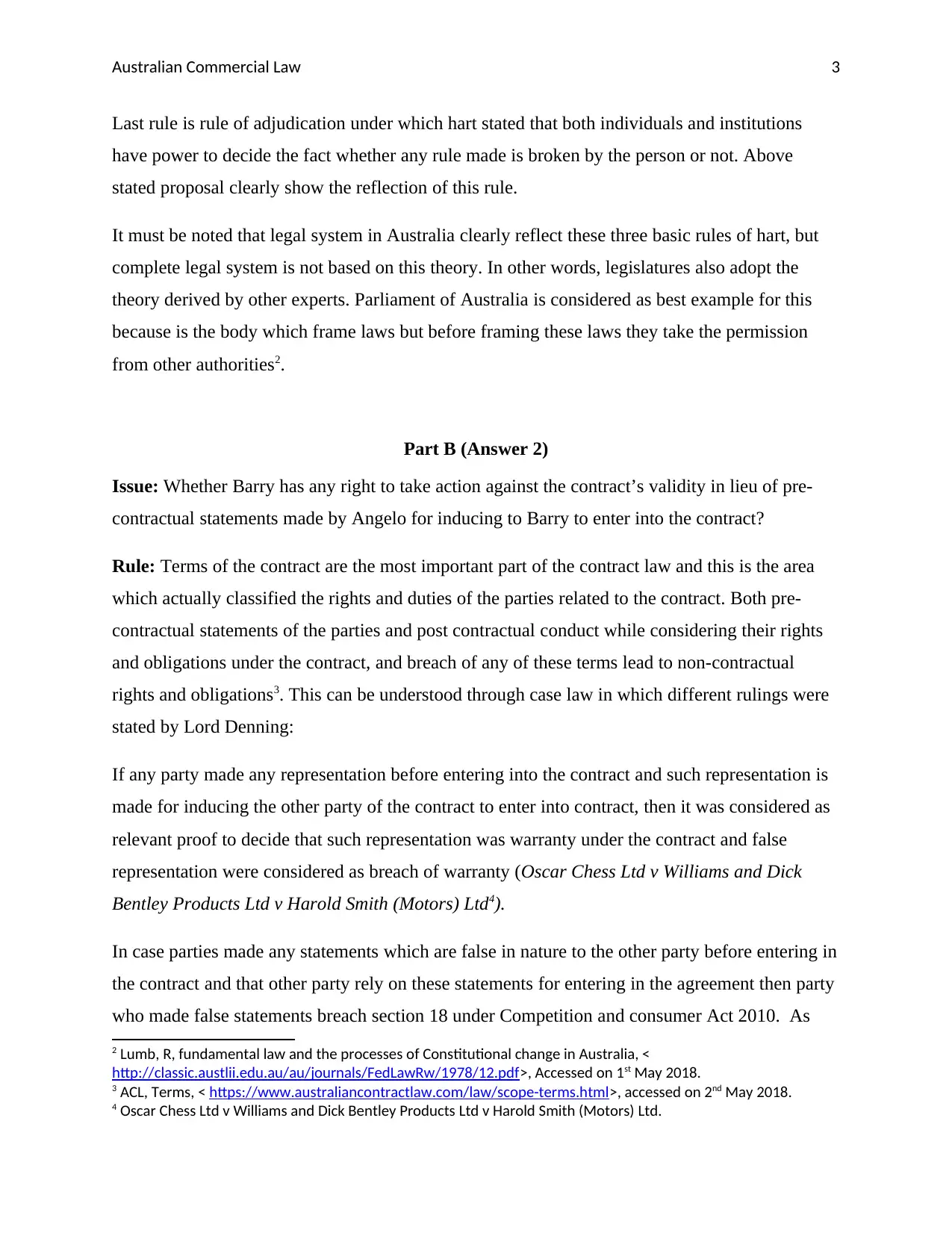
Australian Commercial Law 3
Last rule is rule of adjudication under which hart stated that both individuals and institutions
have power to decide the fact whether any rule made is broken by the person or not. Above
stated proposal clearly show the reflection of this rule.
It must be noted that legal system in Australia clearly reflect these three basic rules of hart, but
complete legal system is not based on this theory. In other words, legislatures also adopt the
theory derived by other experts. Parliament of Australia is considered as best example for this
because is the body which frame laws but before framing these laws they take the permission
from other authorities2.
Part B (Answer 2)
Issue: Whether Barry has any right to take action against the contract’s validity in lieu of pre-
contractual statements made by Angelo for inducing to Barry to enter into the contract?
Rule: Terms of the contract are the most important part of the contract law and this is the area
which actually classified the rights and duties of the parties related to the contract. Both pre-
contractual statements of the parties and post contractual conduct while considering their rights
and obligations under the contract, and breach of any of these terms lead to non-contractual
rights and obligations3. This can be understood through case law in which different rulings were
stated by Lord Denning:
If any party made any representation before entering into the contract and such representation is
made for inducing the other party of the contract to enter into contract, then it was considered as
relevant proof to decide that such representation was warranty under the contract and false
representation were considered as breach of warranty (Oscar Chess Ltd v Williams and Dick
Bentley Products Ltd v Harold Smith (Motors) Ltd4).
In case parties made any statements which are false in nature to the other party before entering in
the contract and that other party rely on these statements for entering in the agreement then party
who made false statements breach section 18 under Competition and consumer Act 2010. As
2 Lumb, R, fundamental law and the processes of Constitutional change in Australia, <
http://classic.austlii.edu.au/au/journals/FedLawRw/1978/12.pdf>, Accessed on 1st May 2018.
3 ACL, Terms, < https://www.australiancontractlaw.com/law/scope-terms.html>, accessed on 2nd May 2018.
4 Oscar Chess Ltd v Williams and Dick Bentley Products Ltd v Harold Smith (Motors) Ltd.
Last rule is rule of adjudication under which hart stated that both individuals and institutions
have power to decide the fact whether any rule made is broken by the person or not. Above
stated proposal clearly show the reflection of this rule.
It must be noted that legal system in Australia clearly reflect these three basic rules of hart, but
complete legal system is not based on this theory. In other words, legislatures also adopt the
theory derived by other experts. Parliament of Australia is considered as best example for this
because is the body which frame laws but before framing these laws they take the permission
from other authorities2.
Part B (Answer 2)
Issue: Whether Barry has any right to take action against the contract’s validity in lieu of pre-
contractual statements made by Angelo for inducing to Barry to enter into the contract?
Rule: Terms of the contract are the most important part of the contract law and this is the area
which actually classified the rights and duties of the parties related to the contract. Both pre-
contractual statements of the parties and post contractual conduct while considering their rights
and obligations under the contract, and breach of any of these terms lead to non-contractual
rights and obligations3. This can be understood through case law in which different rulings were
stated by Lord Denning:
If any party made any representation before entering into the contract and such representation is
made for inducing the other party of the contract to enter into contract, then it was considered as
relevant proof to decide that such representation was warranty under the contract and false
representation were considered as breach of warranty (Oscar Chess Ltd v Williams and Dick
Bentley Products Ltd v Harold Smith (Motors) Ltd4).
In case parties made any statements which are false in nature to the other party before entering in
the contract and that other party rely on these statements for entering in the agreement then party
who made false statements breach section 18 under Competition and consumer Act 2010. As
2 Lumb, R, fundamental law and the processes of Constitutional change in Australia, <
http://classic.austlii.edu.au/au/journals/FedLawRw/1978/12.pdf>, Accessed on 1st May 2018.
3 ACL, Terms, < https://www.australiancontractlaw.com/law/scope-terms.html>, accessed on 2nd May 2018.
4 Oscar Chess Ltd v Williams and Dick Bentley Products Ltd v Harold Smith (Motors) Ltd.
⊘ This is a preview!⊘
Do you want full access?
Subscribe today to unlock all pages.

Trusted by 1+ million students worldwide
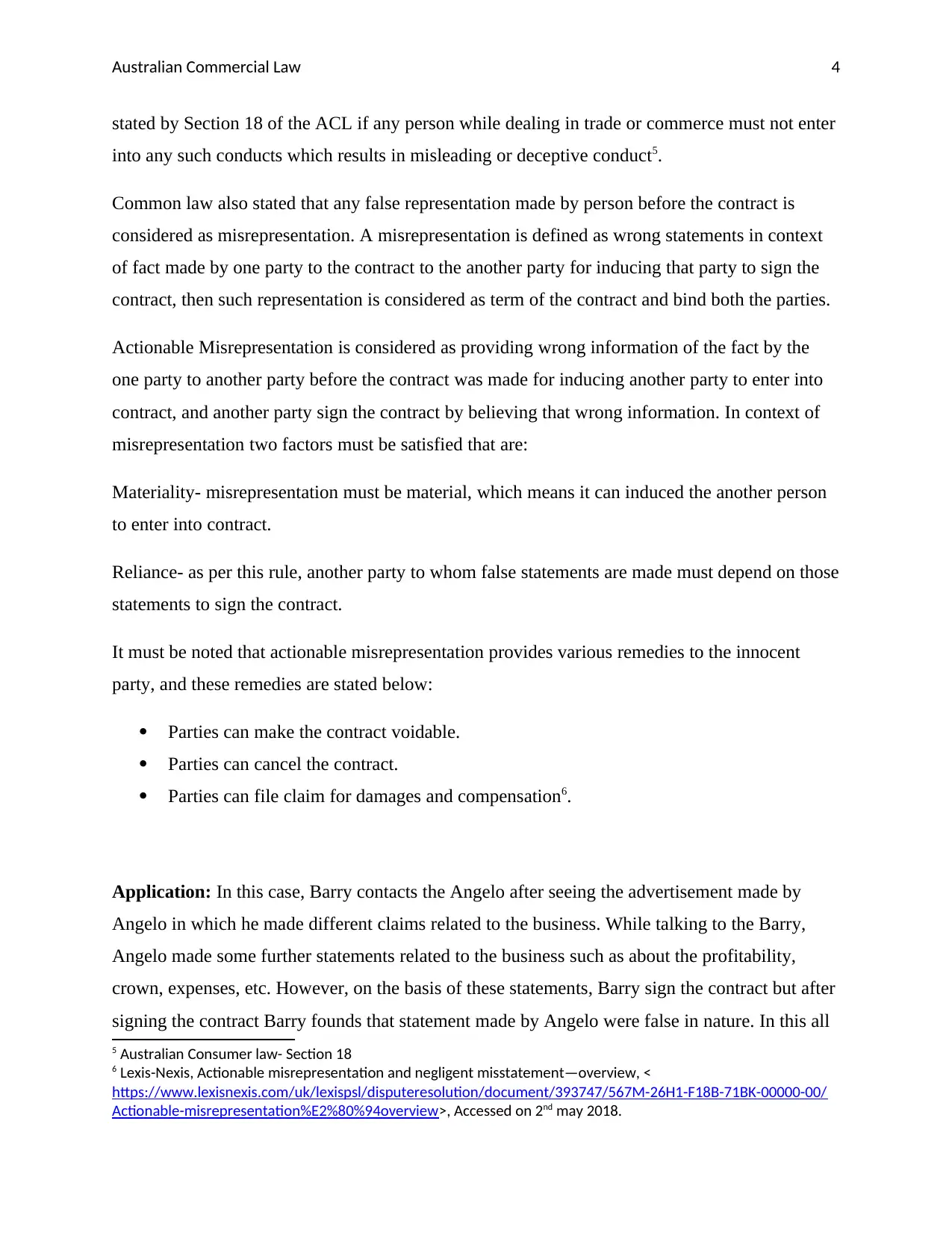
Australian Commercial Law 4
stated by Section 18 of the ACL if any person while dealing in trade or commerce must not enter
into any such conducts which results in misleading or deceptive conduct5.
Common law also stated that any false representation made by person before the contract is
considered as misrepresentation. A misrepresentation is defined as wrong statements in context
of fact made by one party to the contract to the another party for inducing that party to sign the
contract, then such representation is considered as term of the contract and bind both the parties.
Actionable Misrepresentation is considered as providing wrong information of the fact by the
one party to another party before the contract was made for inducing another party to enter into
contract, and another party sign the contract by believing that wrong information. In context of
misrepresentation two factors must be satisfied that are:
Materiality- misrepresentation must be material, which means it can induced the another person
to enter into contract.
Reliance- as per this rule, another party to whom false statements are made must depend on those
statements to sign the contract.
It must be noted that actionable misrepresentation provides various remedies to the innocent
party, and these remedies are stated below:
Parties can make the contract voidable.
Parties can cancel the contract.
Parties can file claim for damages and compensation6.
Application: In this case, Barry contacts the Angelo after seeing the advertisement made by
Angelo in which he made different claims related to the business. While talking to the Barry,
Angelo made some further statements related to the business such as about the profitability,
crown, expenses, etc. However, on the basis of these statements, Barry sign the contract but after
signing the contract Barry founds that statement made by Angelo were false in nature. In this all
5 Australian Consumer law- Section 18
6 Lexis-Nexis, Actionable misrepresentation and negligent misstatement—overview, <
https://www.lexisnexis.com/uk/lexispsl/disputeresolution/document/393747/567M-26H1-F18B-71BK-00000-00/
Actionable-misrepresentation%E2%80%94overview>, Accessed on 2nd may 2018.
stated by Section 18 of the ACL if any person while dealing in trade or commerce must not enter
into any such conducts which results in misleading or deceptive conduct5.
Common law also stated that any false representation made by person before the contract is
considered as misrepresentation. A misrepresentation is defined as wrong statements in context
of fact made by one party to the contract to the another party for inducing that party to sign the
contract, then such representation is considered as term of the contract and bind both the parties.
Actionable Misrepresentation is considered as providing wrong information of the fact by the
one party to another party before the contract was made for inducing another party to enter into
contract, and another party sign the contract by believing that wrong information. In context of
misrepresentation two factors must be satisfied that are:
Materiality- misrepresentation must be material, which means it can induced the another person
to enter into contract.
Reliance- as per this rule, another party to whom false statements are made must depend on those
statements to sign the contract.
It must be noted that actionable misrepresentation provides various remedies to the innocent
party, and these remedies are stated below:
Parties can make the contract voidable.
Parties can cancel the contract.
Parties can file claim for damages and compensation6.
Application: In this case, Barry contacts the Angelo after seeing the advertisement made by
Angelo in which he made different claims related to the business. While talking to the Barry,
Angelo made some further statements related to the business such as about the profitability,
crown, expenses, etc. However, on the basis of these statements, Barry sign the contract but after
signing the contract Barry founds that statement made by Angelo were false in nature. In this all
5 Australian Consumer law- Section 18
6 Lexis-Nexis, Actionable misrepresentation and negligent misstatement—overview, <
https://www.lexisnexis.com/uk/lexispsl/disputeresolution/document/393747/567M-26H1-F18B-71BK-00000-00/
Actionable-misrepresentation%E2%80%94overview>, Accessed on 2nd may 2018.
Paraphrase This Document
Need a fresh take? Get an instant paraphrase of this document with our AI Paraphraser
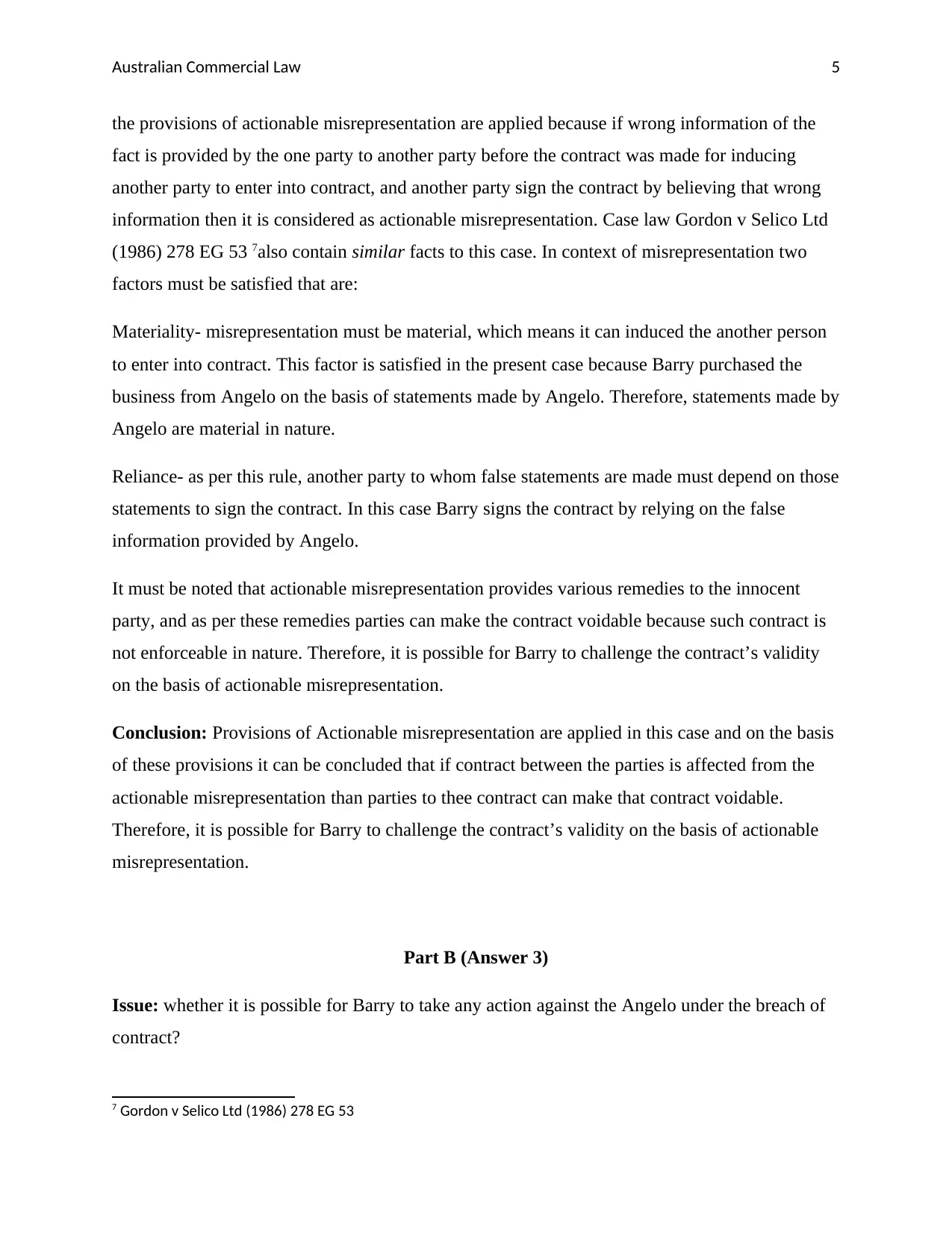
Australian Commercial Law 5
the provisions of actionable misrepresentation are applied because if wrong information of the
fact is provided by the one party to another party before the contract was made for inducing
another party to enter into contract, and another party sign the contract by believing that wrong
information then it is considered as actionable misrepresentation. Case law Gordon v Selico Ltd
(1986) 278 EG 53 7also contain similar facts to this case. In context of misrepresentation two
factors must be satisfied that are:
Materiality- misrepresentation must be material, which means it can induced the another person
to enter into contract. This factor is satisfied in the present case because Barry purchased the
business from Angelo on the basis of statements made by Angelo. Therefore, statements made by
Angelo are material in nature.
Reliance- as per this rule, another party to whom false statements are made must depend on those
statements to sign the contract. In this case Barry signs the contract by relying on the false
information provided by Angelo.
It must be noted that actionable misrepresentation provides various remedies to the innocent
party, and as per these remedies parties can make the contract voidable because such contract is
not enforceable in nature. Therefore, it is possible for Barry to challenge the contract’s validity
on the basis of actionable misrepresentation.
Conclusion: Provisions of Actionable misrepresentation are applied in this case and on the basis
of these provisions it can be concluded that if contract between the parties is affected from the
actionable misrepresentation than parties to thee contract can make that contract voidable.
Therefore, it is possible for Barry to challenge the contract’s validity on the basis of actionable
misrepresentation.
Part B (Answer 3)
Issue: whether it is possible for Barry to take any action against the Angelo under the breach of
contract?
7 Gordon v Selico Ltd (1986) 278 EG 53
the provisions of actionable misrepresentation are applied because if wrong information of the
fact is provided by the one party to another party before the contract was made for inducing
another party to enter into contract, and another party sign the contract by believing that wrong
information then it is considered as actionable misrepresentation. Case law Gordon v Selico Ltd
(1986) 278 EG 53 7also contain similar facts to this case. In context of misrepresentation two
factors must be satisfied that are:
Materiality- misrepresentation must be material, which means it can induced the another person
to enter into contract. This factor is satisfied in the present case because Barry purchased the
business from Angelo on the basis of statements made by Angelo. Therefore, statements made by
Angelo are material in nature.
Reliance- as per this rule, another party to whom false statements are made must depend on those
statements to sign the contract. In this case Barry signs the contract by relying on the false
information provided by Angelo.
It must be noted that actionable misrepresentation provides various remedies to the innocent
party, and as per these remedies parties can make the contract voidable because such contract is
not enforceable in nature. Therefore, it is possible for Barry to challenge the contract’s validity
on the basis of actionable misrepresentation.
Conclusion: Provisions of Actionable misrepresentation are applied in this case and on the basis
of these provisions it can be concluded that if contract between the parties is affected from the
actionable misrepresentation than parties to thee contract can make that contract voidable.
Therefore, it is possible for Barry to challenge the contract’s validity on the basis of actionable
misrepresentation.
Part B (Answer 3)
Issue: whether it is possible for Barry to take any action against the Angelo under the breach of
contract?
7 Gordon v Selico Ltd (1986) 278 EG 53
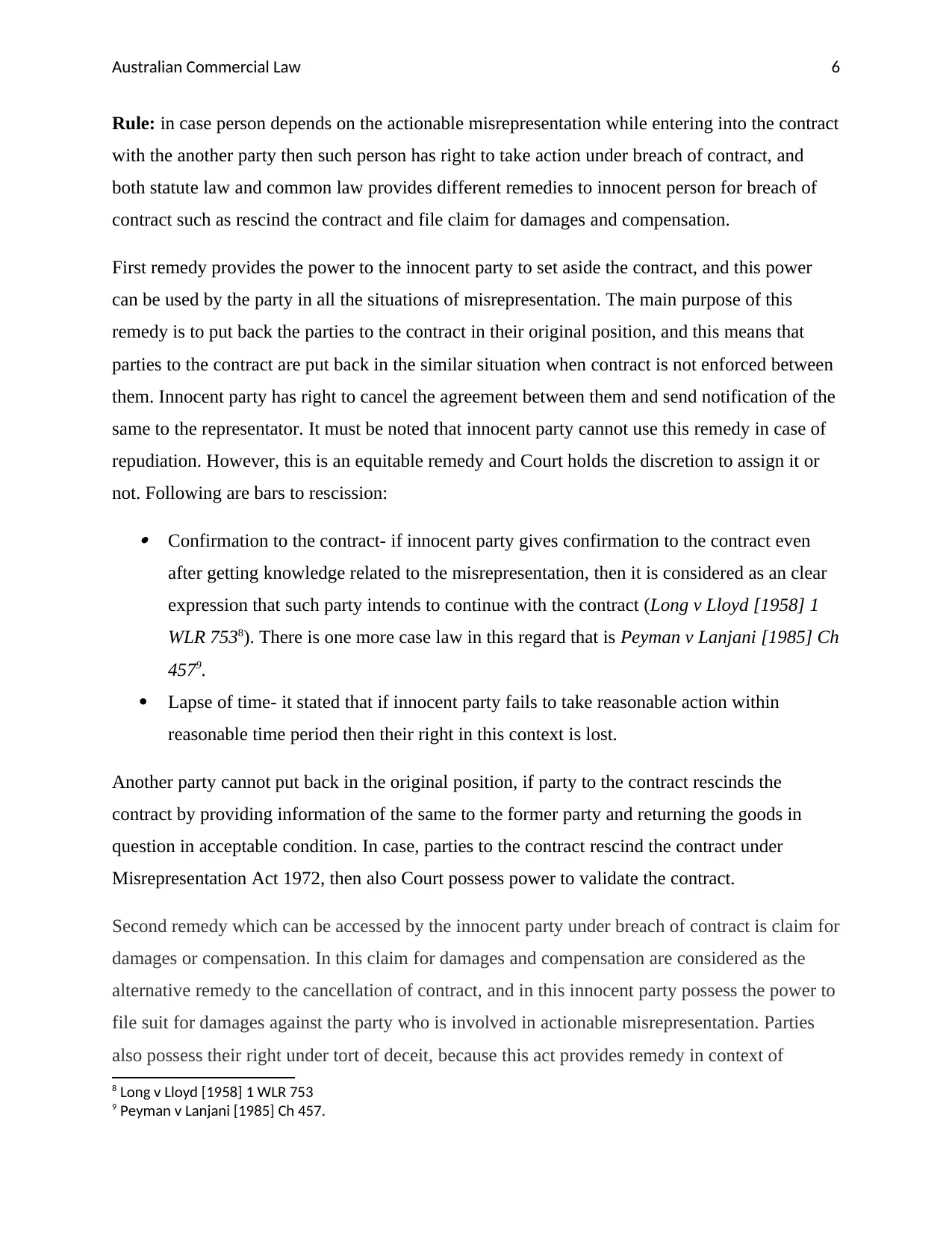
Australian Commercial Law 6
Rule: in case person depends on the actionable misrepresentation while entering into the contract
with the another party then such person has right to take action under breach of contract, and
both statute law and common law provides different remedies to innocent person for breach of
contract such as rescind the contract and file claim for damages and compensation.
First remedy provides the power to the innocent party to set aside the contract, and this power
can be used by the party in all the situations of misrepresentation. The main purpose of this
remedy is to put back the parties to the contract in their original position, and this means that
parties to the contract are put back in the similar situation when contract is not enforced between
them. Innocent party has right to cancel the agreement between them and send notification of the
same to the representator. It must be noted that innocent party cannot use this remedy in case of
repudiation. However, this is an equitable remedy and Court holds the discretion to assign it or
not. Following are bars to rescission:
Confirmation to the contract- if innocent party gives confirmation to the contract even
after getting knowledge related to the misrepresentation, then it is considered as an clear
expression that such party intends to continue with the contract (Long v Lloyd [1958] 1
WLR 7538). There is one more case law in this regard that is Peyman v Lanjani [1985] Ch
4579.
Lapse of time- it stated that if innocent party fails to take reasonable action within
reasonable time period then their right in this context is lost.
Another party cannot put back in the original position, if party to the contract rescinds the
contract by providing information of the same to the former party and returning the goods in
question in acceptable condition. In case, parties to the contract rescind the contract under
Misrepresentation Act 1972, then also Court possess power to validate the contract.
Second remedy which can be accessed by the innocent party under breach of contract is claim for
damages or compensation. In this claim for damages and compensation are considered as the
alternative remedy to the cancellation of contract, and in this innocent party possess the power to
file suit for damages against the party who is involved in actionable misrepresentation. Parties
also possess their right under tort of deceit, because this act provides remedy in context of
8 Long v Lloyd [1958] 1 WLR 753
9 Peyman v Lanjani [1985] Ch 457.
Rule: in case person depends on the actionable misrepresentation while entering into the contract
with the another party then such person has right to take action under breach of contract, and
both statute law and common law provides different remedies to innocent person for breach of
contract such as rescind the contract and file claim for damages and compensation.
First remedy provides the power to the innocent party to set aside the contract, and this power
can be used by the party in all the situations of misrepresentation. The main purpose of this
remedy is to put back the parties to the contract in their original position, and this means that
parties to the contract are put back in the similar situation when contract is not enforced between
them. Innocent party has right to cancel the agreement between them and send notification of the
same to the representator. It must be noted that innocent party cannot use this remedy in case of
repudiation. However, this is an equitable remedy and Court holds the discretion to assign it or
not. Following are bars to rescission:
Confirmation to the contract- if innocent party gives confirmation to the contract even
after getting knowledge related to the misrepresentation, then it is considered as an clear
expression that such party intends to continue with the contract (Long v Lloyd [1958] 1
WLR 7538). There is one more case law in this regard that is Peyman v Lanjani [1985] Ch
4579.
Lapse of time- it stated that if innocent party fails to take reasonable action within
reasonable time period then their right in this context is lost.
Another party cannot put back in the original position, if party to the contract rescinds the
contract by providing information of the same to the former party and returning the goods in
question in acceptable condition. In case, parties to the contract rescind the contract under
Misrepresentation Act 1972, then also Court possess power to validate the contract.
Second remedy which can be accessed by the innocent party under breach of contract is claim for
damages or compensation. In this claim for damages and compensation are considered as the
alternative remedy to the cancellation of contract, and in this innocent party possess the power to
file suit for damages against the party who is involved in actionable misrepresentation. Parties
also possess their right under tort of deceit, because this act provides remedy in context of
8 Long v Lloyd [1958] 1 WLR 753
9 Peyman v Lanjani [1985] Ch 457.
⊘ This is a preview!⊘
Do you want full access?
Subscribe today to unlock all pages.

Trusted by 1+ million students worldwide
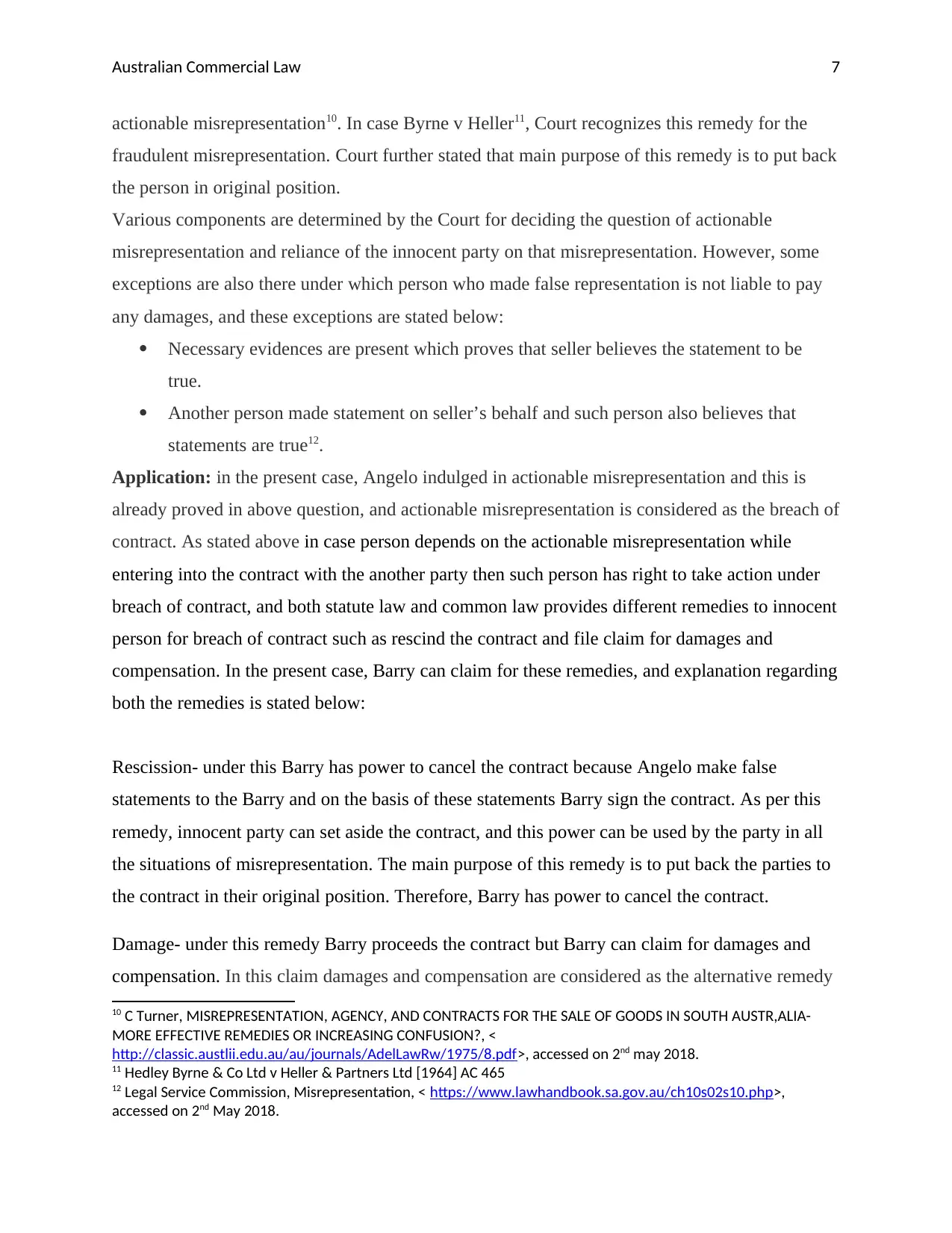
Australian Commercial Law 7
actionable misrepresentation10. In case Byrne v Heller11, Court recognizes this remedy for the
fraudulent misrepresentation. Court further stated that main purpose of this remedy is to put back
the person in original position.
Various components are determined by the Court for deciding the question of actionable
misrepresentation and reliance of the innocent party on that misrepresentation. However, some
exceptions are also there under which person who made false representation is not liable to pay
any damages, and these exceptions are stated below:
Necessary evidences are present which proves that seller believes the statement to be
true.
Another person made statement on seller’s behalf and such person also believes that
statements are true12.
Application: in the present case, Angelo indulged in actionable misrepresentation and this is
already proved in above question, and actionable misrepresentation is considered as the breach of
contract. As stated above in case person depends on the actionable misrepresentation while
entering into the contract with the another party then such person has right to take action under
breach of contract, and both statute law and common law provides different remedies to innocent
person for breach of contract such as rescind the contract and file claim for damages and
compensation. In the present case, Barry can claim for these remedies, and explanation regarding
both the remedies is stated below:
Rescission- under this Barry has power to cancel the contract because Angelo make false
statements to the Barry and on the basis of these statements Barry sign the contract. As per this
remedy, innocent party can set aside the contract, and this power can be used by the party in all
the situations of misrepresentation. The main purpose of this remedy is to put back the parties to
the contract in their original position. Therefore, Barry has power to cancel the contract.
Damage- under this remedy Barry proceeds the contract but Barry can claim for damages and
compensation. In this claim damages and compensation are considered as the alternative remedy
10 C Turner, MISREPRESENTATION, AGENCY, AND CONTRACTS FOR THE SALE OF GOODS IN SOUTH AUSTR,ALIA-
MORE EFFECTIVE REMEDIES OR INCREASING CONFUSION?, <
http://classic.austlii.edu.au/au/journals/AdelLawRw/1975/8.pdf>, accessed on 2nd may 2018.
11 Hedley Byrne & Co Ltd v Heller & Partners Ltd [1964] AC 465
12 Legal Service Commission, Misrepresentation, < https://www.lawhandbook.sa.gov.au/ch10s02s10.php>,
accessed on 2nd May 2018.
actionable misrepresentation10. In case Byrne v Heller11, Court recognizes this remedy for the
fraudulent misrepresentation. Court further stated that main purpose of this remedy is to put back
the person in original position.
Various components are determined by the Court for deciding the question of actionable
misrepresentation and reliance of the innocent party on that misrepresentation. However, some
exceptions are also there under which person who made false representation is not liable to pay
any damages, and these exceptions are stated below:
Necessary evidences are present which proves that seller believes the statement to be
true.
Another person made statement on seller’s behalf and such person also believes that
statements are true12.
Application: in the present case, Angelo indulged in actionable misrepresentation and this is
already proved in above question, and actionable misrepresentation is considered as the breach of
contract. As stated above in case person depends on the actionable misrepresentation while
entering into the contract with the another party then such person has right to take action under
breach of contract, and both statute law and common law provides different remedies to innocent
person for breach of contract such as rescind the contract and file claim for damages and
compensation. In the present case, Barry can claim for these remedies, and explanation regarding
both the remedies is stated below:
Rescission- under this Barry has power to cancel the contract because Angelo make false
statements to the Barry and on the basis of these statements Barry sign the contract. As per this
remedy, innocent party can set aside the contract, and this power can be used by the party in all
the situations of misrepresentation. The main purpose of this remedy is to put back the parties to
the contract in their original position. Therefore, Barry has power to cancel the contract.
Damage- under this remedy Barry proceeds the contract but Barry can claim for damages and
compensation. In this claim damages and compensation are considered as the alternative remedy
10 C Turner, MISREPRESENTATION, AGENCY, AND CONTRACTS FOR THE SALE OF GOODS IN SOUTH AUSTR,ALIA-
MORE EFFECTIVE REMEDIES OR INCREASING CONFUSION?, <
http://classic.austlii.edu.au/au/journals/AdelLawRw/1975/8.pdf>, accessed on 2nd may 2018.
11 Hedley Byrne & Co Ltd v Heller & Partners Ltd [1964] AC 465
12 Legal Service Commission, Misrepresentation, < https://www.lawhandbook.sa.gov.au/ch10s02s10.php>,
accessed on 2nd May 2018.
Paraphrase This Document
Need a fresh take? Get an instant paraphrase of this document with our AI Paraphraser
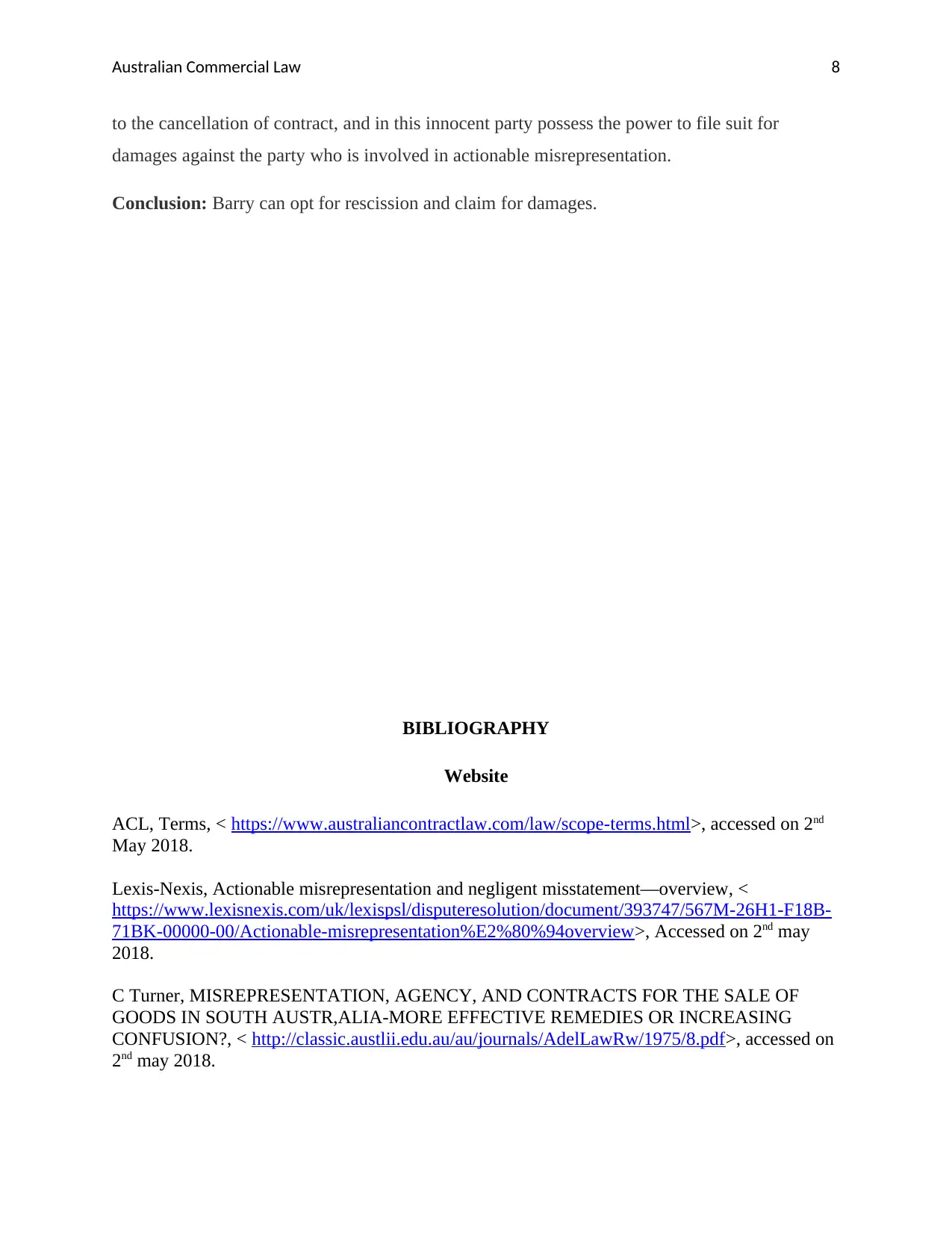
Australian Commercial Law 8
to the cancellation of contract, and in this innocent party possess the power to file suit for
damages against the party who is involved in actionable misrepresentation.
Conclusion: Barry can opt for rescission and claim for damages.
BIBLIOGRAPHY
Website
ACL, Terms, < https://www.australiancontractlaw.com/law/scope-terms.html>, accessed on 2nd
May 2018.
Lexis-Nexis, Actionable misrepresentation and negligent misstatement—overview, <
https://www.lexisnexis.com/uk/lexispsl/disputeresolution/document/393747/567M-26H1-F18B-
71BK-00000-00/Actionable-misrepresentation%E2%80%94overview>, Accessed on 2nd may
2018.
C Turner, MISREPRESENTATION, AGENCY, AND CONTRACTS FOR THE SALE OF
GOODS IN SOUTH AUSTR,ALIA-MORE EFFECTIVE REMEDIES OR INCREASING
CONFUSION?, < http://classic.austlii.edu.au/au/journals/AdelLawRw/1975/8.pdf>, accessed on
2nd may 2018.
to the cancellation of contract, and in this innocent party possess the power to file suit for
damages against the party who is involved in actionable misrepresentation.
Conclusion: Barry can opt for rescission and claim for damages.
BIBLIOGRAPHY
Website
ACL, Terms, < https://www.australiancontractlaw.com/law/scope-terms.html>, accessed on 2nd
May 2018.
Lexis-Nexis, Actionable misrepresentation and negligent misstatement—overview, <
https://www.lexisnexis.com/uk/lexispsl/disputeresolution/document/393747/567M-26H1-F18B-
71BK-00000-00/Actionable-misrepresentation%E2%80%94overview>, Accessed on 2nd may
2018.
C Turner, MISREPRESENTATION, AGENCY, AND CONTRACTS FOR THE SALE OF
GOODS IN SOUTH AUSTR,ALIA-MORE EFFECTIVE REMEDIES OR INCREASING
CONFUSION?, < http://classic.austlii.edu.au/au/journals/AdelLawRw/1975/8.pdf>, accessed on
2nd may 2018.
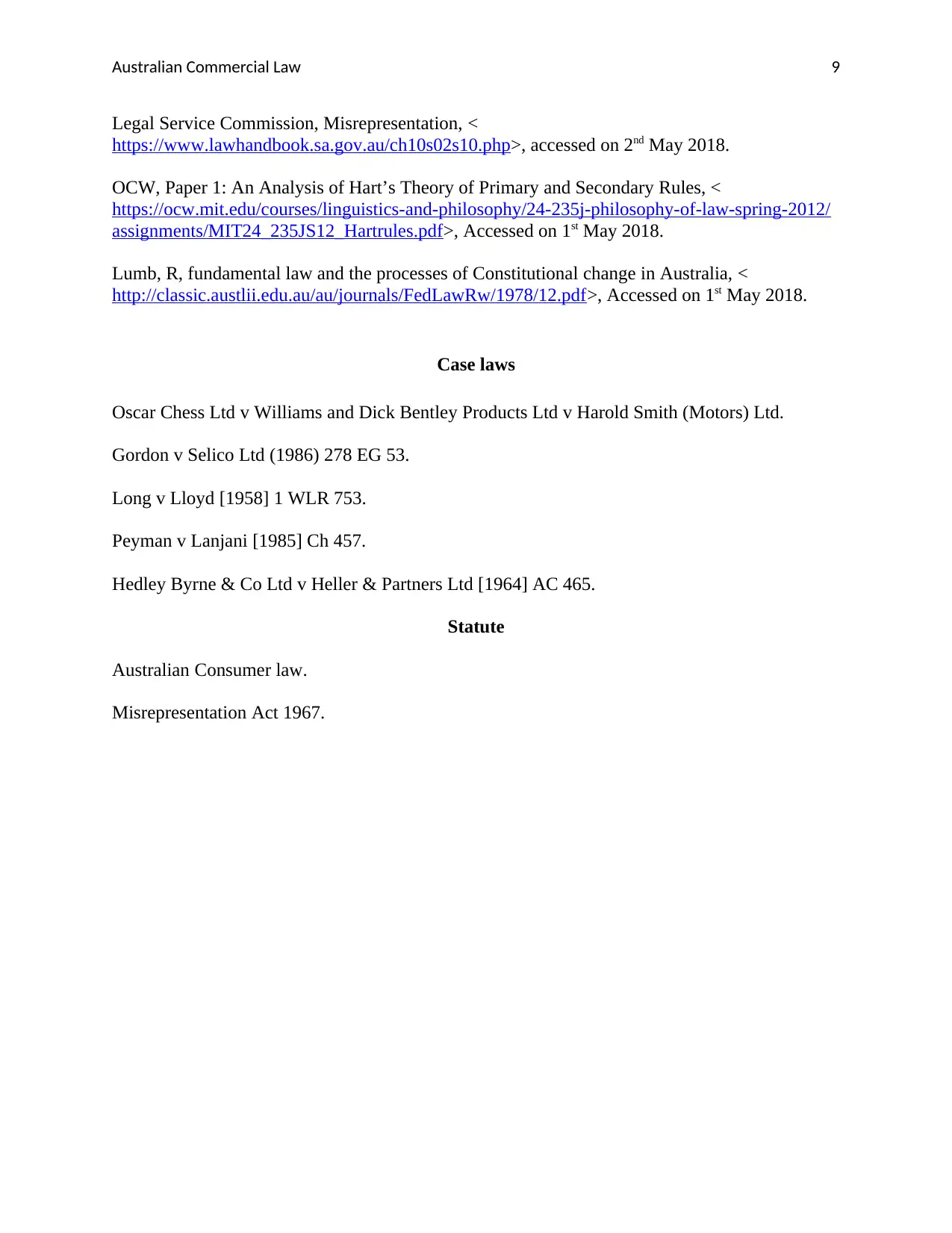
Australian Commercial Law 9
Legal Service Commission, Misrepresentation, <
https://www.lawhandbook.sa.gov.au/ch10s02s10.php>, accessed on 2nd May 2018.
OCW, Paper 1: An Analysis of Hart’s Theory of Primary and Secondary Rules, <
https://ocw.mit.edu/courses/linguistics-and-philosophy/24-235j-philosophy-of-law-spring-2012/
assignments/MIT24_235JS12_Hartrules.pdf>, Accessed on 1st May 2018.
Lumb, R, fundamental law and the processes of Constitutional change in Australia, <
http://classic.austlii.edu.au/au/journals/FedLawRw/1978/12.pdf>, Accessed on 1st May 2018.
Case laws
Oscar Chess Ltd v Williams and Dick Bentley Products Ltd v Harold Smith (Motors) Ltd.
Gordon v Selico Ltd (1986) 278 EG 53.
Long v Lloyd [1958] 1 WLR 753.
Peyman v Lanjani [1985] Ch 457.
Hedley Byrne & Co Ltd v Heller & Partners Ltd [1964] AC 465.
Statute
Australian Consumer law.
Misrepresentation Act 1967.
Legal Service Commission, Misrepresentation, <
https://www.lawhandbook.sa.gov.au/ch10s02s10.php>, accessed on 2nd May 2018.
OCW, Paper 1: An Analysis of Hart’s Theory of Primary and Secondary Rules, <
https://ocw.mit.edu/courses/linguistics-and-philosophy/24-235j-philosophy-of-law-spring-2012/
assignments/MIT24_235JS12_Hartrules.pdf>, Accessed on 1st May 2018.
Lumb, R, fundamental law and the processes of Constitutional change in Australia, <
http://classic.austlii.edu.au/au/journals/FedLawRw/1978/12.pdf>, Accessed on 1st May 2018.
Case laws
Oscar Chess Ltd v Williams and Dick Bentley Products Ltd v Harold Smith (Motors) Ltd.
Gordon v Selico Ltd (1986) 278 EG 53.
Long v Lloyd [1958] 1 WLR 753.
Peyman v Lanjani [1985] Ch 457.
Hedley Byrne & Co Ltd v Heller & Partners Ltd [1964] AC 465.
Statute
Australian Consumer law.
Misrepresentation Act 1967.
⊘ This is a preview!⊘
Do you want full access?
Subscribe today to unlock all pages.

Trusted by 1+ million students worldwide
1 out of 9
Related Documents
Your All-in-One AI-Powered Toolkit for Academic Success.
+13062052269
info@desklib.com
Available 24*7 on WhatsApp / Email
![[object Object]](/_next/static/media/star-bottom.7253800d.svg)
Unlock your academic potential
Copyright © 2020–2025 A2Z Services. All Rights Reserved. Developed and managed by ZUCOL.





